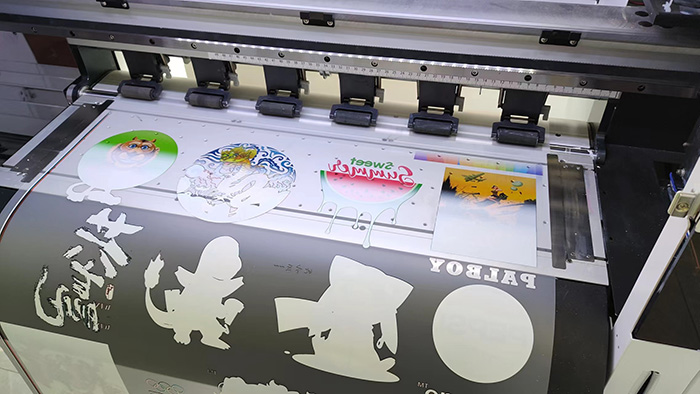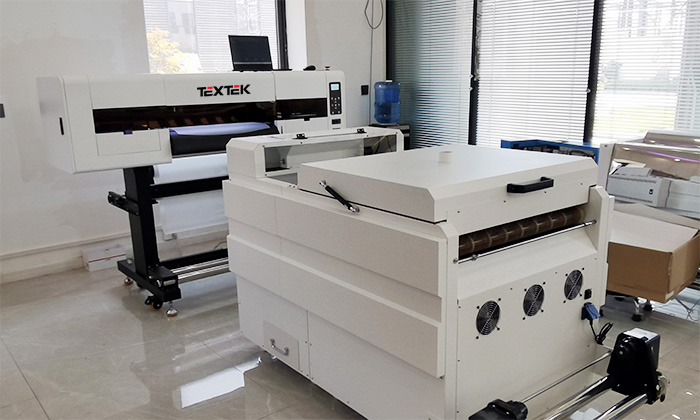DTF Printing Technology

As we had previously announced, the new DTF system that promises to revolutionize the world of T-shirt and textile printing in general is already arriving in BR.
What is the DTF SYSTEM?
It comes from the English acronym “Direct to Film” which means Direct Printing on Film. It consists of printing a special film, with DTF inks, to which an adhesive powder is applied and cured with heat, and then applied to the garment as any transfer or vinyl.
It is applied on cotton, polyester garments and mixtures of both and has as a great differential, that prints WHITE INK and NO BOTTOMS!
The similarity of its name with DTG (Direct to Garment) technology, where printers print directly on the garment, is striking.
It could be said that DTF is a previous step to DTG printers, the difference is that the DTF printer is much cheaper and uses a Film as an intermediary to print on the garment.
Many times it is also compared to the Laser Transfer Prints with white toner, but here too, the DTF wins in the total cost of the initial investment and in the ease of application.
What do we need to print with DTF?
- Inkjet printer adapted for DTF with 6 ink channels CMYK + White.
- Special inks for DTF: they are very elastic inkjet textile inks, which prevents the print from cracking when stretching the garment once printed.
- DTF film: it is the support on which the printing is made.
- DTF powder: it is what allows the DTF inks to adhere to the garment.
- RIP Software: Necessary to properly print the CMYK layers and the White layer, since by itself, the printer would not print in the correct order.
- Heat Press, for transferring and curing.
DTF Printer for Sale
Textek Printer is the largest and most reliable DTF Printers Manufacturer (Direct To Film Supplier) Based in China. We Can Supply You With DTF Printers & PhotoPrint RIP Software, DTF Inks/Cartridges, Transfer Films, DTF Powder and Heat Presses! As a Factory, We Can Offer You the Best DTF Printer Price.

What is the DTF printing process like?
- The image is printed in mirror mode on the film. The white base is printed on top of the colors in one step.
- With the ink still wet, adhesion powder is applied to the surface and the film is cured in a flat bottom oven or heat press for about 5 minutes at 165°.
- Once the film is cured, it is applied to the fabric by pressing it at 165° – 15 seconds on cotton fabrics or 140° – 50 seconds on polyester.
- The film is removed with a uniform movement and soon the garment is printed!
Advantages of DTF
- Prints on Cotton and Polyester and on any background color, white, black, red, etc.
- Possibility of printing white color
- High resistance to washing
- Excellent ink elasticity.
- Does not leave background in the design (only the area with ink is transferred).
Disadvantages of DTF
- By using a printer adapted for this technique, it requires more maintenance and care than a common printer.
- For those who are looking for prints without touch, DTF can be more textured. It is similar to vinyl.
- FIlm requires curing after printing, so it can be a little slower than other techniques such as sublimation.
The advantages or disadvantages really depend on what technique you are comparing it to, and what you are evaluating, whether it is cost, quality, versatility, etc.
Unfortunately there is no ideal technique for T-shirt customization that covers everything we are looking for: good price, good feel, resistance, easy application and that can be applied in all qualities and colors. Each one has pros and cons.
If you are evaluating to start in the t-shirt customization business or if you are already working and want to expand the possibilities of your business, we believe it is a good option, since with only one technique, you can cover almost all types of t-shirts and all background colors.
If you already work in sublimation, you will be able to incorporate cotton and dark colored t-shirts to your production, which will allow you to expand your business.
You can even offer this technique as an outsourced service to other entrepreneurs or to the final consumer, since once the design has been cured, it can be stored and even delivered to your customers so that they can apply it themselves.






